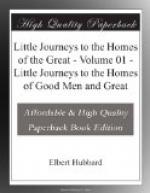It requires two to make a home. The first home was made when a woman, cradling in her loving arms a baby, crooned a lullaby. All the tender sentimentality we throw around a place is the result of the sacred thought that we live there with some one else. It is “our” home. The home is a tryst—the place where we retire and shut the world out. Lovers make a home, just as birds make a nest, and unless a man knows the spell of the divine passion I hardly see how he can have a home at all. He only rents a room.
Camden is separated from the city of Philadelphia by the Delaware River. Camden lies low and flat—a great, sandy, monotonous waste of straggling buildings. Here and there are straight rows of cheap houses, evidently erected by staid, broad-brimmed speculators from across the river, with eyes on the main chance. But they reckoned ill, for the town did not boom. Some of these houses have marble steps and white, barn-like shutters, that might withstand a siege. When a funeral takes place in one of these houses, the shutters are tied with strips of mournful, black alpaca for a year and a day. Engineers, dockmen, express-drivers and mechanics largely make up the citizens of Camden. Of course, Camden has its smug corner where prosperous merchants most do congregate: where they play croquet in the front yards, and have window-boxes, and a piano and veranda-chairs and terra-cotta statuary; but for the most part the houses of Camden are rented, and rented cheap.
Many of the domiciles are frame and have the happy tumbledown look of the back streets in Charleston or Richmond—those streets where the white trash merges off into prosperous colored aristocracy. Old hats do duty in keeping out the fresh air where Providence has interfered and broken out a pane; blinds hang by a single hinge; bricks on the chimney-tops threaten the passersby; stringers and posts mark the place where proud picket fences once stood—the pickets having gone for kindling long ago. In the warm, Summer evenings, men in shirt-sleeves sit on the front steps and stolidly smoke, while children pile up sand in the streets and play in the gutters.
Parallel with Mickle Street, a block away, are railway-tracks. There noisy switch-engines that never keep Sabbath, puff back and forth, day and night, sending showers of soot and smoke when the wind is right (and it usually is) straight over Number 328, where, according to John Addington Symonds and William Michael Rossetti, lived the mightiest seer of the century—the man whom they rank with Socrates, Epictetus, Saint Paul, Michelangelo and Dante.
It was in August of Eighteen Hundred Eighty-three that I first walked up that little street—a hot, sultry Summer evening. There had been a shower that turned the dust of the unpaved roadway to mud. The air was close and muggy. The houses, built right up to the sidewalks, over which, in little gutters, the steaming sewage ran, seemed to have discharged their occupants into the street to enjoy the cool of the day. Barefooted children by the score paddled in the mud. All the steps were filled with loungers; some of the men had discarded not only coats but shirts as well, and now sat in flaming red underwear, holding babies.




